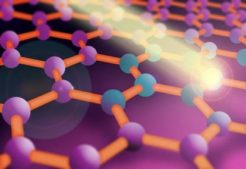While providing an overview of different types of narrowband electromagnetic absorbers, researchers from the Zhejiang University in Hangzhou and the Taiyuan University of Technology in China point out ways to create effective broadband/multiband absorbers with crucial applications in fields like solar-energy harvesting. The review article “Plasmonic and metamaterial structures … [Read more...]
No-Power Wi-Fi Connectivity May Boost Internet of Things
Researchers at the University of Washington have developed a communication system that uses radio frequency signals and repurposes existing Wi-FI infrastructure to supply power and provide Internet connectivity, respectively, to battery-free devices. Known as Wi-Fi backscatter, this technology is the first of its kind capable of connecting battery-free devices to Wi-Fi … [Read more...]
Wireless Power Transfer Employs Mini Receivers for Greater Efficiency
Scientists in Korea have developed a new wireless power transfer (WPT) technique using miniaturized receivers that enables more efficient wireless power transfer at greater distances than ever before. WPTuses overlapping magnetic fields, rather than wires, to transmit electric power. This technology is believed to have wide range of potential uses, from wireless cell phone … [Read more...]
Controlling Graphene’s Conductivity Using Light
Researchers at MIT have discovered a novel way of controlling graphene’s electrical behavior, using light pulses to modify the material’s conductivity. Because of its lightness and efficacy, graphene has been one of the most talked-about materials in recent years, with a wide range of still-untapped uses and applications in science and technology. In a paper recently published … [Read more...]
Scientists Investigate ‘Quantum Glue’ Trigger for Superconductivity
Physicists at the University of Illinois at Chicago have identified the “quantum glue” that binds electrons together to evoke superconductivity in a crucial step towards the creation of high-speed energy transport methods that conduct electricity without current loss. The new research, published online in the Proceedings of the National Academy of Sciences, is a collaboration … [Read more...]
New Single-Photon Optical Transistor Could Lead to Faster Data Transmission
Using an ultracold quantum gas, researchers at the Max Planck Institute of Quantum Optics in Germany have created a new kind of transistor-like optical amplifier that allows for a twentyfold amplification of single-photon signals. Although fiberoptic technology has helped speed along data transmission and telecommunications in general, researchers have hoped to find another … [Read more...]
Lasers Could Replace Quartz in Oscillators
Researchers at the California Institute of Technology have a developed a new method that uses a pair of laser beams, instead of a quartz crystal, to tune oscillators. The achievement could provide a better frequency reference to future consumer electronics and high-end navigation and radar systems. Present in nearly all electronic devices, oscillators are electronic circuits … [Read more...]
Optical Cables Made of Air Could Boost Laser Communications
A breakthrough in the development of waveguide technology could extend the reach of light signals to support long-range laser communications and environmental monitoring in the upper atmosphere and beyond, reports new research from scientists at the University of Maryland. Known as an “air waveguide,” the new technology acts much like a fiber-optic cable, guiding light beams … [Read more...]
Tunable Nanoantennas Made More Customizable than Ever Before
Researchers at the University of Illinois at Urbana-Champaign have developed a new kind of tunable nanoantenna that could point towards novel plasmonic-based optomechanical systems that use plasmonic field enhancement to instantiate mechanical motion. The research, led by Kimani Toussaint, Ph.D., associate professor of mechanical science and engineering at the University of … [Read more...]
New Hyperbolic Metamaterial Lets Light Out, Not In
Researchers at the National Institute for Standards and Technology (NIST) have developed a new metamaterial made of silver, glass, and chromium that allows for the one-way transmission of visible light. Metamaterials are artificial materials engineered, combined and structured, often in patterns, to achieve certain properties. Among other functions, certain metamaterials can … [Read more...]
- « Previous Page
- 1
- …
- 29
- 30
- 31
- 32
- 33
- …
- 41
- Next Page »













